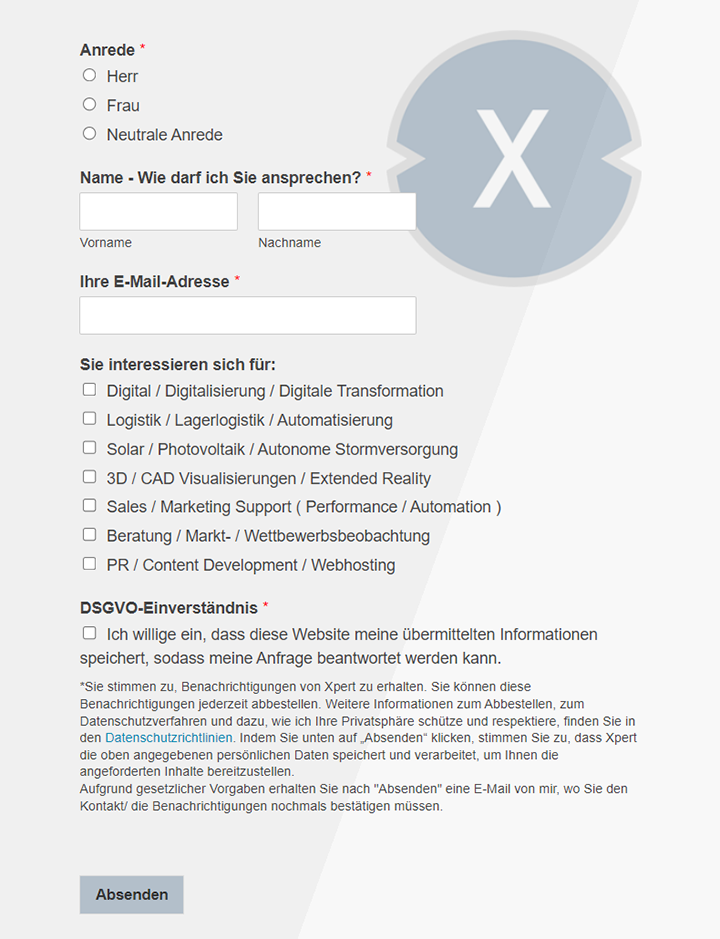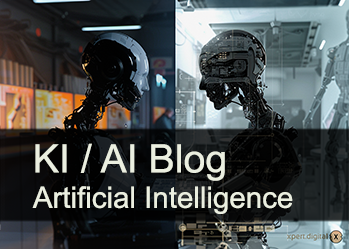No longer science fiction: Human machines – What humanoid robots can do better than any other machine
Language selection 📢
Published on: September 14, 2025 / Updated on: September 14, 2025 – Author: Konrad Wolfenstein

No longer science fiction: Human machines – What humanoid robots can do better than any other machine – Image: Xpert.Digital
The rise of robot colleagues: Why BMW and Mercedes are now relying on human machines
More than just AI: The one big problem that is still slowing down the triumph of humanoid robots
Long the stuff of science fiction, they are now entering the factory floors of the real world: A new era of automation is dawning, driven by humanoid robots that no longer operate as specialized machines in shielded areas, but as versatile assistants right by our side. This paradigm shift is made possible by the convergence of two megatrends: groundbreaking advances in artificial intelligence that enable robots to learn through observation, and highly sophisticated sensor and actuator technology that gives them human-like movements.
While automotive giants like BMW and Mercedes-Benz, as well as global logistics companies, are already launching initial pilot projects to automate monotonous and physically demanding tasks, the path to mass adoption is still paved with considerable hurdles. Limited battery life, unresolved safety issues, and still-high acquisition costs are slowing widespread deployment. Nevertheless, forecasts are gigantic, and a global race between the US and China for technological supremacy is already in full swing. Are we at the beginning of a revolution that will have a lasting impact on our working world and society, or is this merely hype with unresolved teething issues? This overview sheds light on the current state of the art, the biggest challenges, and the far-reaching visions behind the new era of robotics.
Suitable for:
- A market analysis and overview of humanoid robots with a payload of 10 kg or more, for purchase and rental options
The new robot era: Why humanoid machines could shape the future of automation
Are we on the verge of a paradigm shift in robotics? While traditional industrial robots have served as specialized workhorses in restricted production areas for decades, a new generation of humanoid robots is paving their way into the human workforce. The question is no longer whether these machines will arrive, but how quickly they will prevail and what role they will play in our future.
What makes humanoid robots so special?
What distinguishes a humanoid robot from a conventional industrial robot? The answer lies in its fundamental design philosophy. A humanoid robot has a human-like body structure with two arms, two legs, and a movable upper body. This configuration opens up entirely new possibilities, allowing the machines to operate in environments originally designed for humans.
The key advantage lies in their universal adaptability. While traditional robots are specifically designed for specific tasks and often require extensive modifications to the work environment, humanoid robots can theoretically be deployed anywhere humans work. They use the same doors, stairs, and work surfaces, and operate the same tools and machines.
Which technological advances will enable the breakthrough?
How did decades of research suddenly become a market-ready technology? The answer lies in the convergence of several technological developments. On the one hand, advances in electromechanical actuators and significant improvements in sensor technology have created the hardware foundation. Modern humanoid robots are equipped with sophisticated camera systems, lidar sensors, microphones, and force-torque sensors. Tactile sensors enable them to detect whether they are in contact with objects or people.
On the other hand, artificial intelligence has become the most important enabler for humanoid robots. Breakthroughs in this field have been achieved faster than even experts expected. Generative AI models are revolutionizing the possibilities for interaction with robots and could be the key to providing robots with world models that they can use to navigate their environment.
How do large behavior models revolutionize robot control?
What happens when robots are no longer programmed, but trained? Boston Dynamics is demonstrating a completely new approach with its Atlas robot: Large Behavior Models (LBMs). These allow the robot to learn complex tasks through observation, rather than being programmed in detail for each movement.
The technology works similarly to language models: Atlas can learn both simple pick-and-place tasks and more complex manipulations such as tying a rope, turning a bar stool, or spreading a tablecloth. What's particularly remarkable is that these tasks would be extremely difficult to implement using traditional robot programming techniques, as they involve deformable geometries and complex manipulation sequences.
Where do humanoid robots already work today?
Which companies are already using humanoid robots in practice? The list of commercial applications is still manageable, but certainly impressive. Agility Robotics has taken on a pioneering role with its Digit robot. The company signed a multi-year contract with logistics service provider GXO in mid-2024. The Digit robots are used in a textile company, where they remove crates from transport racks and place them on conveyor belts.
BMW has been testing humanoid robots from the California-based company Figure at its Spartanburg, California, plant for about a year. The Figure 02 robots take sheet metal parts from a transport rack and place them into a fixture. Mercedes-Benz is also testing humanoid robots from the Texas-based company Apptronik at its Digital Factory Campus in Berlin and in production plants. The Apollo robots still have relatively simple tasks: transporting components or modules to the production line or performing initial quality checks.
Why are automobile manufacturers in particular pioneers?
What makes the automotive industry an ideal testing ground for humanoid robots? The industry faces several challenges that humanoid robots can address. First, there is an acute shortage of skilled workers, especially in physically demanding areas. Second, modern production methods require greater flexibility that traditional, permanently installed robots cannot offer.
Humanoid robots offer a decisive advantage here: They can be integrated into existing production lines without the need for extensive modifications. This is particularly valuable in brownfield situations, where existing facilities are to be automated. Their human-like form allows the robots to use the same tools and workstations as human workers.
What challenges limit its use?
Why aren't humanoid robots yet in widespread use? The biggest hurdles lie in several critical areas. Battery performance represents a fundamental challenge. Current humanoid robots have a battery life of only 2 to 4 hours. For practical use, an improvement to at least 4 to 5 hours with rapid charging within one hour is necessary.
The problem lies in the energy intensity of upright movement. Standing and walking stably upright is energy-intensive and requires enormous computing power, which consumes a correspondingly large amount of energy. Walking on two legs is less efficient than rolling. A humanoid robot weighing approximately 80 kg and with a body volume of 80 liters has limited space for batteries when considering limbs, motors, electronics, and structural components.
How complex is the mechanical construction?
What makes the design of humanoid joints so challenging? A human has 140 real joints, and with so-called "false" joints like intervertebral discs, the number rises to 212. A humanoid robot, on the other hand, has to make do with approximately 48 to 68 joints. This reduction leads to compromises in mobility and explains why even advanced robots still appear "stiff in the hips."
The demands on joint technology are extreme. Humanoid robots require highly compact designs that integrate motors, gears, drives, encoders, and sensors into a single module. At the same time, they must offer low weight, low energy consumption, low heat generation, and high response speed. Depending on their position in the body, the requirements vary considerably: leg joints must bear large loads and generate high torques, while arm and wrist joints must be optimized for precision and compactness.
What security risks exist?
Why is safety the biggest hurdle for the mass deployment of humanoid robots? Unlike traditional industrial robots, which operate in enclosed spaces, humanoid robots are designed to work directly with humans. This creates entirely new safety challenges.
A critical problem is balance control. When a robot moves on two legs, a reliable control system must ensure balance. If the control system fails, the robot could fall over and injure people nearby. Humanoid robots are often large, heavy, and powerful. Without appropriate safety precautions, they could inadvertently injure people through collisions, crushing, or falls.
Further complicating matters is the fact that there are still no established safety standards for dynamically stable industrial mobile robots. Although the International Organization for Standardization (ISO) has established a committee to develop safety rules, the standards are still in the development phase.
When will humanoid robots become economically viable?
At what cost do humanoid robots become a commercially attractive alternative? Prices are falling dramatically faster than expected. Currently, most humanoid robots cost between $200,000 and $250,000. Mercedes-Benz Board Member for Production Jörg Burzer is quoted as saying: "Costs will be crucial... if they reach a double-digit thousand-dollar amount—which is absolutely possible—things will get very interesting."
Optimistic forecasts predict significantly lower costs. German consultancy Nexery expects an average selling price of $55,000 by 2030. Morgan Stanley projects that by 2050, the average selling price of a humanoid robot will fall to $50,000, nearly equivalent to the cost of a year of human labor in high-income countries.
The cost analysis becomes particularly interesting when considering total operating time. If a robot works two 8-hour shifts per day, a robot priced at $16,000 effectively costs less than $2.75 per hour in depreciation-adjusted terms over a three-year period.
How big could the market become?
What economic dimensions could humanoid robotics achieve? Forecasts vary considerably, but all indicate enormous growth potential. Morgan Stanley estimates that the market for humanoid robots could reach a volume of $5 trillion by 2050, including associated supply chains and repair, maintenance, and support services. More than 1 billion humanoid robots could be in use by 2050.
The most ambitious forecast comes from Tesla CEO Elon Musk, who predicts that there will be ten billion humanoid robots in the world by 2040—more than the 9.2 billion people the UN predicts will live on Earth in 2040. At the beginning of 2024, Goldman Sachs forecast a market volume of $28 billion by 2035—six times higher than a previous estimate.
A new dimension of digital transformation with 'Managed AI' (Artificial Intelligence) - Platform & B2B Solution | Xpert Consulting

A new dimension of digital transformation with 'Managed AI' (Artificial Intelligence) – Platform & B2B Solution | Xpert Consulting - Image: Xpert.Digital
Here you will learn how your company can implement customized AI solutions quickly, securely, and without high entry barriers.
A Managed AI Platform is your all-round, worry-free package for artificial intelligence. Instead of dealing with complex technology, expensive infrastructure, and lengthy development processes, you receive a turnkey solution tailored to your needs from a specialized partner – often within a few days.
The key benefits at a glance:
⚡ Fast implementation: From idea to operational application in days, not months. We deliver practical solutions that create immediate value.
🔒 Maximum data security: Your sensitive data remains with you. We guarantee secure and compliant processing without sharing data with third parties.
💸 No financial risk: You only pay for results. High upfront investments in hardware, software, or personnel are completely eliminated.
🎯 Focus on your core business: Concentrate on what you do best. We handle the entire technical implementation, operation, and maintenance of your AI solution.
📈 Future-proof & Scalable: Your AI grows with you. We ensure ongoing optimization and scalability, and flexibly adapt the models to new requirements.
More about it here:
Germany in the robotics race: catching up or left behind?
Which countries are leading the development?
Where are the centers of humanoid robotics innovation? Market observers see the USA and China as clearly leading the way. The International Federation of Robotics lists 46 companies worldwide that have developed humanoid robots with legs: eight in North America, 21 in China, and six in Japan and Korea.
In China, the government set clear goals for development in this field years ago and provides substantial support to the industry. In the US, huge sums of venture capital are flowing into robotics startups. There is also strong interest in their use for military and security purposes, leading to significant funding from DARPA and the US Department of Defense.
Suitable for:
- The end of automation? More than just machines: Discover how robots think, feel and operate independently
What role does Germany play in humanoid robotics?
Can Germany still catch up in humanoid robotics? The only German player to have achieved significant prominence in this field is Neura Robotics, based in Metzingen near Stuttgart. Founded in 2019, the company focuses not primarily on humanoid robots, but rather on "cognitive robots." Of the five robots in its program, only one is humanoid.
The German Research Center for Artificial Intelligence (DFKI) is working intensively on the future of humanoid robotics. The Systems AI for Robot Learning (SAIROL) research department develops learning-based control algorithms for humanoid robots. The DFKI Robotics Innovation Center in Bremen is researching innovative methods for safe and self-learning robot control.
What are the main areas of application?
In which areas will humanoid robots be used first? The first commercial applications will focus on logistics and manufacturing, where tasks are repetitive and structured. Over 90 percent of the humanoid robots predicted for 2050 will be used for industrial and commercial purposes, with less than 10 percent in households.
In manufacturing, humanoid robots can perform a wide variety of tasks: machine control, loading production lines, transporting workpieces between workstations, assembly work, loading and unloading machines, welding, screwing, polishing and grinding, gluing and dispensing, inspection and quality control, and painting work.
How does the way of working change from deterministic to autonomous?
What does the paradigm shift from deterministic to autonomous robotics mean? While traditional robots' movements are programmed down to the smallest detail, humanoid robots are designed to perceive and analyze their environment, and, at least within certain limits, make autonomous decisions about their actions.
This transformation is not limited to humanoid robots, but can also be applied to stationary robots or those on wheels. AI is initially independent of the design and can be used in various "embodiments." Nevertheless, humanoid robots offer unique advantages due to their versatility and adaptability to human environments.
What alternative concepts are there?
Are two legs always the best solution? Many developers and users are asking themselves whether a robot with two legs is really the optimal solution, or whether one with four legs might be more suitable. Four-legged robots are already in productive use: Boston Dynamics' robot dog "Spot" has been traipsing through Audi and BMW factories for some time now, scanning the equipment and creating digital factory twins.
Apptronik has designed its Apollo robot modularly. Depending on the application, the customer can choose to have the torso mounted on a mobile base with wheels or on a fixed base. This flexibility demonstrates that not all applications require a fully humanoid robot.
Which industries will be transformed first?
Where will the transformation brought about by humanoid robots be felt most quickly? The logistics industry is at the forefront. GXO Logistics, one of the world's largest contract logistics providers, sees humanoid robots as a potential solution to ongoing labor shortages and the demand for adaptive automation. The robots take over repetitive, physically demanding tasks, freeing human workers to focus on safer, more creative activities.
In automotive production, BMW, Mercedes-Benz, and other manufacturers are demonstrating how humanoid robots can be integrated into existing iFactory initiatives. This digital production strategy aims to increase efficiency, sustainability, and flexibility in manufacturing.
What are the long-term societal impacts?
How will humanoid robots change the world of work? While automation could potentially displace 85 million jobs by 2025, it will simultaneously create 97 million new roles, many of them related to robot management and maintenance. In manufacturing, 2.1 million jobs could remain vacant by 2030, with robot maintenance and programming among the most in-demand skills.
Humanoid robots are transforming jobs rather than simply eliminating them. They are taking over typically dangerous, repetitive, and physically demanding tasks and shifting human workers into higher-value positions such as robot programming, maintenance, process optimization, and quality control.
What ethical questions arise?
What social and ethical considerations must be taken into account? A key question lies in what societies ultimately want to "allow" the technology to do and what framework they set for it. The integration of humanoid robots requires careful consideration of job security and workforce acceptance.
Use in private households and in the care of the elderly is particularly sensitive. Safety considerations will ensure that humanoid robots only enter these areas in the final stages of development. One expert is quoted as saying: "As long as they can't prove that a humanoid robot will never fall on a baby, it won't work in the home either."
How is production capacity developing?
When will humanoid robots become available in larger quantities? The first manufacturers are already finalizing plans for series production. Figure has announced plans to establish a robot production facility where humanoid robots will produce humanoid robots. At the start of series production, the capacity will be 12,000 robots per year.
Apptronik has entered into a partnership with Florida-based contract manufacturer Jabil, which will now produce the Apollo robots worldwide. Tesla is planning ambitious production targets: internal plans for approximately 10,000 Optimus units are to be realized in 2024, and production version 2 with a capacity of 10,000 units per month are to be launched in 2025.
What determines success or failure?
What factors will determine the widespread adoption of humanoid robots? Success depends on addressing several critical challenges. Technically, advances must be made in robustness, resilience, energy supply, motor control, and artificial intelligence. Economically, costs must continue to fall and production volumes must increase to achieve economies of scale.
Regulatory safety standards and legal frameworks will be crucial. Social acceptance of the new technology must be created. Much of the development takes place within tech companies, involving enormous investments that far exceed public investment. This leads to a lack of transparency and makes realistic assessments of actual progress difficult.
How do humanoids differ from traditional industrial robots?
What makes humanoid robots structurally different from conventional automation solutions? Traditional industrial robots are optimized for specific tasks and operate with significantly fewer joints, making them easier to control, faster, and more reliable. They will therefore continue to be the backbone of automation for production tasks that require high speed and high precision.
Humanoid robots, on the other hand, are generalists. Their strength lies not in their speed or precision at individual tasks, but in their versatility and adaptability. They can theoretically perform any task a human can perform, albeit possibly more slowly or with less precision. This flexibility makes them particularly valuable in dynamic environments where requirements change frequently.
What technological breakthroughs are still pending?
Which innovations could bring about the final breakthrough? Solid-state batteries promise higher energy density, improved safety, and longer lifespans compared to traditional lithium-ion batteries. This technology could solve the energy density problem and enable humanoid robots to operate for longer periods.
In actuator technology, new joint concepts are being developed, such as the Archimedes Drive, which promises high torques with a compact design and quiet operation. Advances in materials science could enable lighter and stronger components.
How realistic are the optimistic forecasts?
Are the trillion-dollar forecasts realistic or exaggerated? Experts are divided. On the one hand, the technical challenges beyond tech demos are still considerable. On the other hand, developments are accelerating exponentially, driven by enormous private investment and competition between tech giants.
Broader industrial application is not expected for another five to ten years. Higher production volumes are needed to reduce costs. The introduction of humanoid robots is expected to be relatively slow until the mid-2030s, accelerating in the late 2030s and into the 2040s.
What does this mean for the future of work?
How will human-robot interaction evolve? The future lies not in replacing human workers with robots, but in intelligent cooperation. Humanoid robots will complement human skills, not replace them. They will take on physically demanding, repetitive, or dangerous tasks, while humans can focus on creative, strategic, and interpersonal activities.
This development requires massive investments in retraining and continuing education. Companies implementing humanoid robots report an average 35 percent increase in employee training costs. New job profiles are emerging: robot trainers and supervisors, maintenance specialists, process designers, and creative problem solvers.
Humanoid robotics is at a turning point. While the technical foundations have been laid and initial commercial deployments demonstrate what is possible, significant challenges remain. Success will depend on whether the industry strikes the balance between technical innovation, commercial viability, regulatory certainty, and social acceptance. The next five to ten years will be crucial in determining whether humanoid robots truly take over human spaces or remain a niche technology for the time being.
We are there for you - advice - planning - implementation - project management
☑️ SME support in strategy, consulting, planning and implementation
☑️ Creation or realignment of the AI strategy
☑️ Pioneer Business Development
I would be happy to serve as your personal advisor.
You can contact me by filling out the contact form below or simply call me on +49 89 89 674 804 (Munich) .
I'm looking forward to our joint project.
Xpert.Digital - Konrad Wolfenstein
Xpert.Digital is a hub for industry with a focus on digitalization, mechanical engineering, logistics/intralogistics and photovoltaics.
With our 360° business development solution, we support well-known companies from new business to after sales.
Market intelligence, smarketing, marketing automation, content development, PR, mail campaigns, personalized social media and lead nurturing are part of our digital tools.
You can find out more at: www.xpert.digital - www.xpert.solar - www.xpert.plus



























